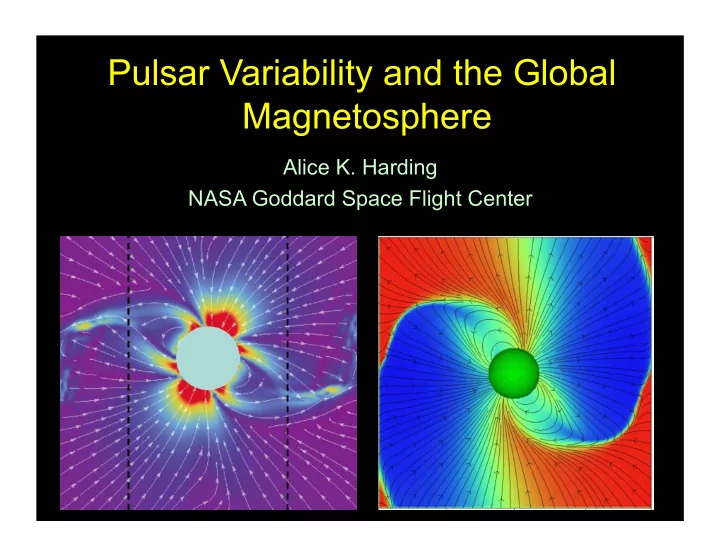

Pulsar Variability and the Global Magnetosphere Alice K. Harding NASA Goddard Space Flight Center
Observed pulsar variability • Spin-down state changes ( γ -ray, X-ray and radio) • Mode switching • Intermittent pulsars • [Glitches]
Spin-down state changes - γ -ray PSR J2021+4026 Simultaneous decrease in γ -ray flux (20%) and increase in spin-down rate (4%) Allafort et al. 2013 Energy flux Change in pulse profile after ˙ ν change in
Spin-down state changes - γ -ray PSR J2021+4026 Now possibly returning to previous state (Ng et al. 2016) Light curve modeling before and after 1 st state change – Emission moves higher in magnetosphere? (C. Venter)
Spin-down state changes – B0540-69 • 36% increase in spin-down rate • No change in X-ray flux Marshall et al. 2015
Spin-down state changes – radio pulsars Lyne et al. 2010 • Correlated changes in pulse width and spin-down rate • Pulsars fluctuate between two stable spin-down states on ~year timescales Δ ˙ ν ν ~ 0.3% − 10% • Meta-stable states of magnetosphere/current flow?
Pulse profile and spin-down changes Lyne et al. 2010 • Darker/lighter profiles correspond to higher/lower ˙ ν state • Spin-down rate larger when core component of the radio profile is brighter • In high state, precursor is ˙ ν weaker and interpulse is stronger
PSR B0740-28 – Link between magnetosphere and NS interior? Profile shape and spin-down rate become stronger after glitch (Keith et al. 2013) glitch
PSR J1119-6127 – profile change after a glitch • Pulse profile changed from usual single to double following large glitch (Weltevrede et al. (2011) • Post-glitch smaller ˙ ν
Intermittent pulsars – B1931+24 • Bimodal spin-down states • Radio on/off states: larger/smaller spin-down rates – 3/2 ratio • Different magnetosphere/ Kramer et al. 2006 charge density states? • Change it particle flux/ pulsar wind? Young et al. 2014
Intermittent pulsars – J1841-0500 and J1832+0029 J1832+0029: ˙ on = 1.8 ˙ J1841-0500: ˙ on = 2.5 ˙ ν ν ν ν off off Camilo et al. 2012 Lorimer et al. 2012
Multifrequency mode switching – B0943+10 Hermsen et al. 2013 • Simultaneous changes in radio and Q mode B mode X-ray emission • B mode: radio pulse bright: X-ray emission is unpulsed & mostly non- thermal or thermal (Mereghetti et al. 2013) • Q mode: radio pulse weak: the X-ray emission shows an additional pulsed thermal component
Inter-pole communication Weltevrede et al. 2007, 2012 B1055-52 and B1702-19: phase-locked flux MP IP modulation of MP and IP in phase delayed by 2.5P and 0.5P B1822-09: Coordinated mode switching - in Q mode IP turns on when MP component turns off ! B Q B Gil et al. 1994 How do poles communicate with each other?
Global pulsar magnetospheres Larger current flow larger spin-down rate (Harding et al. 1999) 2 T ≈ 2 I pc B 0 R pc 3 c Color: charge density, Streamlines: magnetic field
Resistive pulsar magnetospheres Drift Color: charge density, Streamlines: magnetic field Conductivity velocity Low conductivity Medium conductivity Infinite conductivity (force free) J = c ρ E × B 2 + σ E || B 2 + E 0 α = 0 0 As conductivity increases: • Charge and current density increase α = 45 0 • Current sheet gets stronger • Field lines get straighter • Spin-down power α = 90 0 increases Kalapotharakos, Kazanas, Harding & Contopoulos 2012
Spin-down and magnetosphere conductivity Intermittent pulsars: ˙ P L = 4 π 2 I • On state : high σ , near force-free P 3 • Off state: low σ , near vacuum Off On L on /L off σ / Ω Inclination angle (degrees) Kalapotharakos, Kazanas, Harding & Contopoulos 2012 Li, Spitkovsky & Tchekhovskoy 2012
Conductivity and phase-resolved spectra Matching dissipative models to Fermi light curves and spectra for 8 bright pulsars (Brambilla et al. 2015) Observed Model: α = 60 0 , ζ = 50 0 , σ = 10 Ω Decesar 2013 Brambilla et al. 2015
Trends with conductivity The σ values that best describe each of the 8 bright pulsars (with published phase-resolved spectra) show an increase with the spin ˙ down rate and a decrease with the pulsar age, expected if pair E cascades are providing the magnetosphere conductivity ( σ ). Age vs σ Spin-down rate vs σ Brambilla et al. 2015
Modes of pair creation Harding & Muslimov 1998 • Curvature radiation pair e - front High pair multiplicity complete screening e + • Inverse Compton scattering pair front Low pair multiplicity incomplete screening Closed field region
Polar cap pair death lines Harding & Muslimov 2002 B0540-69 CR ICS ˙ changing ν Intermittent Mode switching
Partially screened gaps For high surface B, pulsars are near critical T for free surface emission Switch between vacuum and partially screened gaps Szary et al. 2015 Szary et al. 2011
Pair cascades vs. current Sub-Goldreich- Julian currents – 0 < J/J GJ < 1 NO pair cascades Super- Goldreich- Julian currents – J/J GJ > 1 Pair cascades Anti-Goldreich- Julian currents - J/ J GJ > 0 Pair cascades Timokhin & Arons 2013
Pair modes and the global magnetosphere Structure of magnetosphere and acceleration regions depends on rate of pair injection (conductivity) Particle-in-cell simulations: Varying uniform injection of neutral plasma from 4, 8 and 16 particles per cell Brambilla et al. 2015 Near force-free E || concentrates near current sheet Near vacuum E || (color) widespread Field lines near dipole
Summary • Spin-down changes, intermittency – Different magnetosphere states stable up to years – Global changes driven different conductivity (current, plasma injection)? • Mode switching – Modes of polar cap pair creation (CR or ICS)?
Recommend
More recommend